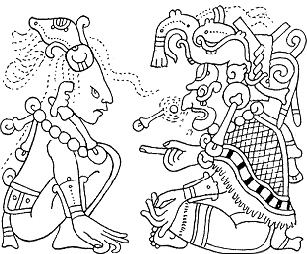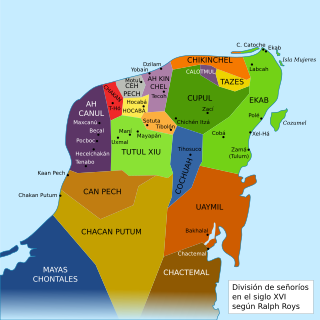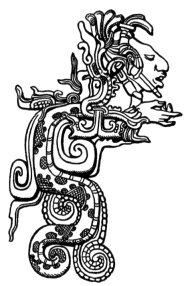
Chaac is the name of the Maya god of rain, thunder, and lighting. With his lightning axe, Chaac strikes the clouds, causing them to produce thunder and rain. Chaac corresponds to Tlaloc among the Aztecs.

Mayapan is a Pre-Columbian Maya site a couple of kilometers south of the town of Telchaquillo in Municipality of Tecoh, approximately 40 km south-east of Mérida and 100 km west of Chichen Itza; in the state of Yucatán, Mexico. Mayapan was the political and cultural capital of the Maya in the Yucatán Peninsula during the Late Post-Classic period from the 1220s until the 1440s. Estimates of the total city population are 15,000–17,000 people, and the site has more than 4,000 structures within the city walls, and additional dwellings outside.

Uxmal is an ancient Maya city of the classical period located in present-day Mexico. It is considered one of the most important archaeological sites of Maya culture, along with Palenque, Chichen Itza and Calakmul in Mexico, Caracol and Xunantunich in Belize, and Tikal in Guatemala. It is located in the Puuc region of the western Yucatán Peninsula, and is considered one of the Maya cities most representative of the region's dominant architectural style. It has been designated a UNESCO World Heritage Site in recognition of its significance.

The Itza are a Maya ethnic group native to the Péten region of northern Guatemala and parts of Belize. The majority of Itza are inhabitants of the city of Flores on Lake Petén Itzá, and nearby portions of Belize where they form an ethnic minority.

El Castillo, also known as the Temple of Kukulcan' is a Mesoamerican step-pyramid that dominates the center of the Chichen Itza archaeological site in the Mexican state of Yucatán. The temple building is more formally designated by archaeologists as Chichen Itza Structure 5B18.

Hunac Ceel Cauich was a Maya general from Telchaquillo who conquered Chichen Itzá and founded the Cocom dynasty. While the rulers of Chichen Itzá were in part descendants of Toltec outsiders who might have been disliked for being foreign oppressors or the war a simple one of conquest, the Maya history attributes the cause of the war to the theft of a wife of a powerful ruler by a power lord.
Chac-Xib-Chac is a figure in Maya mythology. He was a ruler of Chichén Itzá. He probably ruled during the plot of Hunac Ceel. He is mentioned several times in the Chilam Balam of Chumayel. Chac-Xib-Chac was said by some scholars to be one of the names of the Red Bacab, and some experts believe that this may actually be the name of the red rain god who lived in the east.

Chichén Itzá was a large pre-Columbian city built by the Maya people of the Terminal Classic period. The archeological site is located in Tinúm Municipality, Yucatán State, Mexico.

Until the discovery that Maya stelae depicted kings instead of high priests, the Maya priesthood and their preoccupations had been a main scholarly concern. In the course of the 1960s and over the following decades, however, dynastic research came to dominate interest in the subject. A concept of royal ʼshamanismʼ, chiefly propounded by Linda Schele and Freidel, came to occupy the forefront instead. Yet, Classic Maya civilization, being highly ritualistic, would have been unthinkable without a developed priesthood. Like other Pre-Hispanic Mesoamerican priesthoods, the early Maya priesthood consisted of a hierarchy of professional priests serving as intermediaries between the population and the deities. Their basic skill was the art of reading and writing. The priesthood as a whole was the keeper of knowledge concerning the deities and their cult, including calendrics, astrology, divination, and prophecy. In addition, they were experts in historiography and genealogy. Priests were usually male and could marry. Most of our knowledge concerns Yucatán in the Late Postclassic, with additional data stemming from the contemporaneous Guatemalan Highlands.

Ah Canul was the name of a Maya Kuchkabal of the northwest Yucatán Peninsula, before the arrival of the Spanish conquistadors in the 16th century.

Ah Kin Chel was the name of a Maya chiefdom or Kuchkabal of the northern Yucatán Peninsula, before the arrival of the Spanish conquistadors in the 16th century.

Cupul or Kupul, was the name of a Maya chiefdom at time of the Spanish conquest of Yucatán. Cupul was one of the most extensive and densely populated Maya provinces on the Yucatán Peninsula. It was formed in the mid-fifteenth century after the fall of Mayapan and reached its maximum power during the sixteenth century, at the time of their own Spanish conquest led by the adelantado Francisco de Montejo. According to the Encyclopedia Yucatán in time, the Mayan voice ku-pul, means that throws the bouncing, giving a connotation referring to the Mayan ballplayers that existed in the region.

Hocabá-Homún, Hokabá-Homún or Hocabá was the name of a Maya Kuchkabal of the northwestern Yucatán Peninsula, before the arrival of the Spanish conquistadors in the sixteenth century.

Tutul-Xiu, also Tutul Xiues or Mani, was the name of a Mayan chiefdom of the central Yucatán Peninsula with capital in Maní, before the arrival of the Spanish conquistadors in the sixteenth century.
Ah Suytok Tutul Xiu or Ah Zuytok Tutul Xiu was the spiritual leader of the Maya Tutul Xiu people. Founder of the city of Uxmal in the 7th century, he was from the Nonohual. Nonohual's location is unknown, but was probably in Peten, it also might have been another name for Potonchán in Tabasco or Tula. He was also known by his nickname coconut kaba or "Hun Uitzil Chac".
Ah Mekat Tutul Xiu established an alliance between Uxmal, Chichen Itza and Mayapan in the span of thirteen years. He founded the League of Mayapan; a confederation between the Maya in Yucatán. Other than the three capitals, it included the manors of Izamal, Tulum, Ichpatún, the Cocom and others. This alliance existed from 987 to 1461. In 1194, the Itza for the second time abandoned Chichén Itzá to settle in the Petén. Later, Hunac Ceel would separate the Itza from the rest of the League.

Ah Xiu Xupan (Maya glyphs ) was the last known ruler of the Mayan chiefdom of Tutul-Xiu when it was part of the League of Mayapan.

The Peten Itza kingdom was a kingdom centered on the island-city of Nojpetén on Lake Peten Itza.
Ah Ulil or more commonly Ulil was a Maya ruler of Izamal during the eleventh century.
The Cult of the Cenote was a legendary tradition by the Mayan particularly under the rulership of the Mayapan in the Yucatán Peninsula. The tradition includes throwing selected people in the city's cenote as a human sacrifice as well as precious stones like gold, jade and other ornaments for the rain god, Chaac. The Sacred Cenote is surrounded by ancient Mayan ruins known as the Chichen Itza which translates into the "mouth of the well in Itza". The ceremonies conducted in the Sacred Cenote were expected by the people to produce rain.

![]()
![]()
![]()
![]()
![]()
![]()
![]() ) was a confederation of Maya states in the Postclassic period of Mesoamerica on the Yucatan peninsula.
) was a confederation of Maya states in the Postclassic period of Mesoamerica on the Yucatan peninsula.













